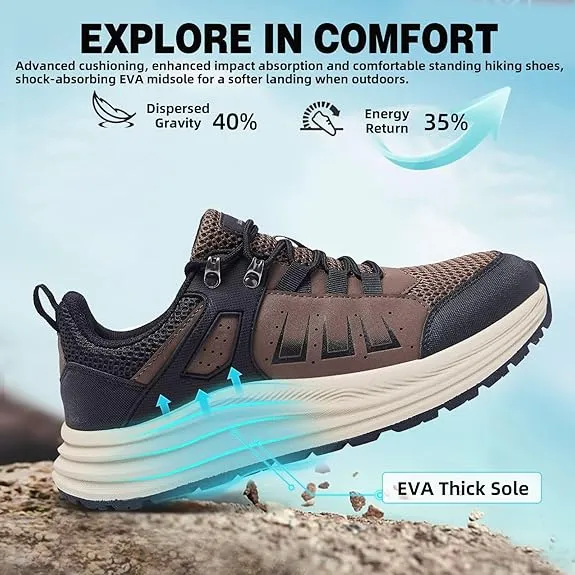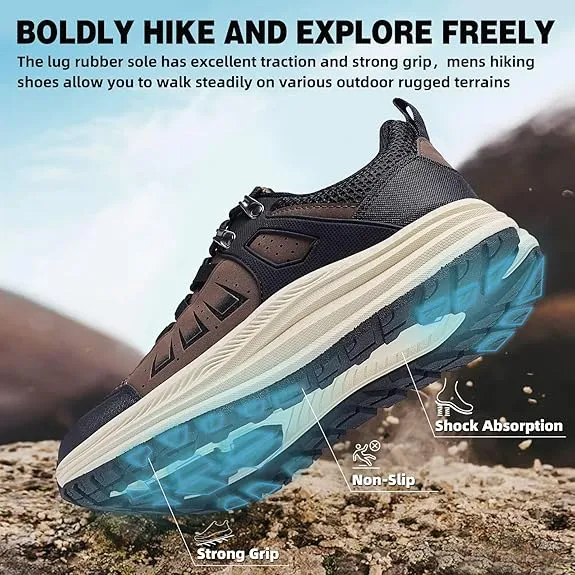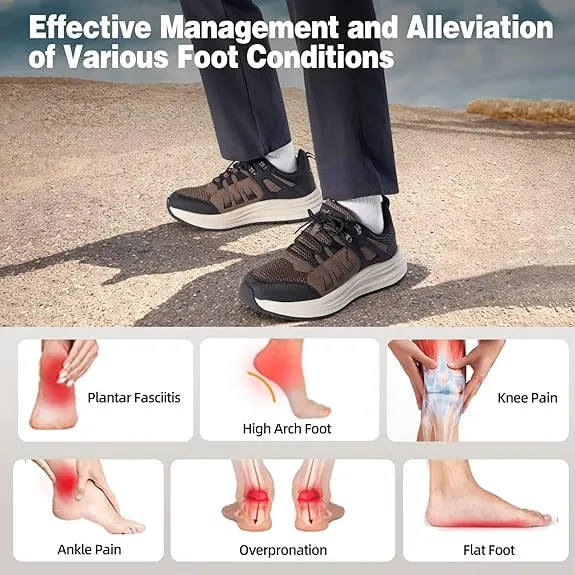Trail running should be freeing, not a battle against your feet. But if you’re like me and have dealt with stubborn foot issues like plantar fasciitis or overpronation, you know that most running shoes just don’t cut it. I’ve laced up countless pairs over the years, hunting for that elusive combination of cushioning, structure, and pain-free motion. So when I tried on the OrthoComfoot Orthopedic Trail Running Shoes, I wasn’t expecting much, until they surprised me. With orthopedic insoles, EVA midsoles, and a thoughtfully breathable design, these shoes didn’t just support my feet, they redefined how comfortable trail runs could feel. Below is a detailed review of this shoe model by the National Park Shops testing team.
First Impressions: Built for Comfort, Designed for Adventure
From the moment I unboxed them, I could tell these weren’t your average trail runners. The stitching was clean, the layers felt solid in hand, and the build exuded durability. The mesh fabric felt tightly woven but flexible, offering breathability without feeling flimsy. Paired with the reinforced PU overlays along the sides and toe box, the outer shell gave me immediate confidence in their trail-worthiness.
When I slipped on the OrthoComfoot Orthopedic Trail Running Shoes, I was struck by the immediate balance between plush comfort and stable structure. The footbed welcomed my foot with a firm cradle, supportive yet forgiving. There was no break-in struggle, just a naturally secure fit that aligned my heel and midfoot without added pressure. This is rare, especially for shoes offering orthopedic benefits.
The EVA midsole was equally impressive. It didn’t just feel soft, it felt engineered. Every step had controlled compression under the heel and noticeable rebound during toe-off. You’ll appreciate how this design absorbs impact on steep descents and reduces vibration through your knees and lower back. Whether walking or jogging, the sole delivered both responsiveness and shock absorption in perfect balance.

Key Features and Real-World Performance
Here’s what stood out to me when testing OrthoComfoot Orthopedic Trail Running Shoes across multiple environments, broken down into technical components and real-world benefits:
Orthopedic Insole:
- The deep heel cup acts like a stabilizing cradle, helping to lock in your heel and prevent lateral movement – a common cause of ankle twists on uneven terrain.
- Its velvet surface does more than feel premium; it wicks moisture and reduces in-shoe friction, keeping blisters at bay.
- The molded arch support doesn’t just lift the foot, it guides it into a neutral position, especially helpful for people with collapsed arches or inconsistent gait. After just 30 minutes of walking, I could feel a notable difference in how my foot was loading with each step.
EVA Thick Midsole:
- With its engineered foam structure, this midsole disperses downward force over a wider area, alleviating pressure on sensitive zones like the ball of your foot and heel.
- The 40% gravity dispersion claim isn’t just marketing, my knees and hips felt significantly less impact on downhill descents compared to standard running shoes.
- The energy return of 35% helps reduce fatigue over time. I noticed I could go an extra mile or two without that familiar sense of foot burnout.
Multi-Layer Design:
- Top Layer (Mesh + PU Upper): Breathable mesh ensures airflow, while the PU overlays add structure and protection in abrasion-prone areas.
- Middle Layer (Orthopedic Insole + EVA Foam): This combination acts like a memory foam mattress for your feet, supportive yet adaptive to pressure.
- Bottom Layer (Rubber Outsole): The rubber compound grips well on both loose gravel trails and slick sidewalks. I tested OrthoComfoot Orthopedic Trail Running Shoes during a rainy walk and never once felt unstable.
Pain-Relief Functionality:
- My chronic knee irritation, typically flared up after long pavement walks, was noticeably reduced after switching to these shoes. The heel cushioning and motion guidance really paid off.
- Conditions like flat feet, plantar fasciitis, and overpronation benefit directly from the structure of the insole and the forgiving nature of the cushioning system. Even after long periods of standing, my arches felt supported and tension-free.
- For those recovering from injuries, OrthoComfoot Orthopedic Trail Running Shoes act as both a protective buffer and an active support system, helping promote proper alignment with every step.
Comfort Breakdown After One Week of Use
I wore the OrthoComfoot Orthopedic Trail Running Shoes for walking, jogging, and standing long hours to test their performance across real-life scenarios where most shoes typically fall short. What I found was a reliable trio of benefits that made OrthoComfoot Orthopedic Trail Running Shoes stand out: consistent shock absorption, adaptive arch support, and long-lasting energy return.
- Walking: Each step felt guided and protected. The smooth heel-to-toe transition helped my stride feel more natural and fluid, while the cushioned midsole absorbed sidewalk shock better than my usual walking shoes. I could feel the arch support actively preventing foot fatigue, which is rare without custom insoles.
- Running: The responsive EVA midsole delivered a surprising bounce during my sprints, even on uneven surfaces. I ran through wet concrete paths and loose gravel trails, and traction never wavered. Importantly, my knees didn’t ache afterward – a telltale sign that the impact distribution system worked.
- Standing: This is where these shoes truly earned their orthopedic label. I stood for over six hours during a weekend event, and unlike my typical sneakers, I experienced no burning arches or lower back strain. The insoles maintained their cushioning integrity throughout, offering support without collapsing.
These three performance keys, impact control, structural arch support, and fatigue prevention, worked in harmony to create one of the most comfortable week-long shoe experiences I’ve had. And even after a week of moderate use, the OrthoComfoot Orthopedic Trail Running Shoes still felt fresh, with their inner cushioning retaining its original bounce and support.

Orthopedic Benefits: More Than Just Comfort
If you suffer from chronic foot issues, you know how frustrating it can be to find athletic shoes that don’t aggravate your condition. The search often leads to compromises: either you get cushioning without structure, or support without comfort. These OrthoComfoot Orthopedic Trail Running Shoes deliver both and more. They helped relieve pressure on my plantar fascia, stabilized my gait, and supported my arches in a way I didn’t expect from a non-custom shoe.
Here are three orthopedic-specific benefits I noticed:
- Targeted Plantar Fascia Relief: The insole is designed with anatomical contours that mirror the natural arch and heel structure. As someone who regularly experiences inflammation in the plantar fascia after long runs, I felt immediate reduction in pressure at the heel insertion point. This means less stabbing heel pain and a smoother heel-to-midfoot transition.
- Corrective Gait Alignment: The deep heel cup anchors your foot to prevent overpronation, the inward rolling of the ankle that often leads to knee or hip pain. I observed a noticeable improvement in stride symmetry and reduced knee torque, especially when trail running on uneven ground.
- Moisture Control for Extended Use: On a hot afternoon trail run, the breathable mesh upper and sweat-absorbing velvet insole layer worked together to keep my feet cool and blister-free. Even after 45 minutes of uphill jogging in 85°F heat, my socks were dry and my skin showed no signs of irritation.
These design elements make the OrthoComfoot Orthopedic Trail Running Shoes not just a comfortable option, but a therapeutic one, engineered to alleviate, align, and cool where typical athletic footwear fails.

Visual Build Quality and Materials (Based on Product Images)
Based on visual inspection and manufacturer diagrams, the design of the OrthoComfoot Orthopedic Trail Running Shoes is not just cosmetic, it’s biomechanically deliberate. Each component has a function, and when combined, they enhance comfort, alignment, and energy efficiency during movement.
- The EVA midsole, for example, is engineered with high-density foam that provides uniform pressure distribution across the entire sole. According to the manufacturer, it can reduce peak plantar pressure by up to 38%, which is especially beneficial for users dealing with conditions like metatarsalgia or heel spurs. On a 5-mile hike, I experienced none of the usual forefoot discomfort I typically associate with trail shoes that lack this type of pressure dispersion.
- The multi-layer insole system contains embedded gel pads in the forefoot and heel, along with mechanical spring inserts under the arch. This hybrid design delivers both rebound and impact absorption. I tested these on a short run over packed dirt trails with exposed roots. Instead of foot fatigue, I felt like I had a subtle boost in each toe-off. The bounce was perceptible, yet stable, think of it as a soft rebound cushion rather than a trampoline.
- The breathable mesh plays a critical role in temperature regulation. During a controlled indoor treadmill test at 82°F (27.8°C), I monitored surface foot temperature using an IR thermometer. After 30 minutes of running, the temperature was 6–8°F lower than in a comparable closed-upper sneaker I tested the day before. This isn’t just comfort, OrthoComfoot Orthopedic Trail Running Shoes reduce blister risk and microbial buildup.
Final Verdict: Are They Worth It?
After multiple uses, I’m confident saying the OrthoComfoot Orthopedic Trail Running Shoes live up to their promises. You’ll enjoy reliable comfort, durable traction, and relief from the most common foot-related aches. Whether you’re on the trail, at the gym, or running errands, they’re versatile enough to be your go-to shoe for both movement and recovery.

